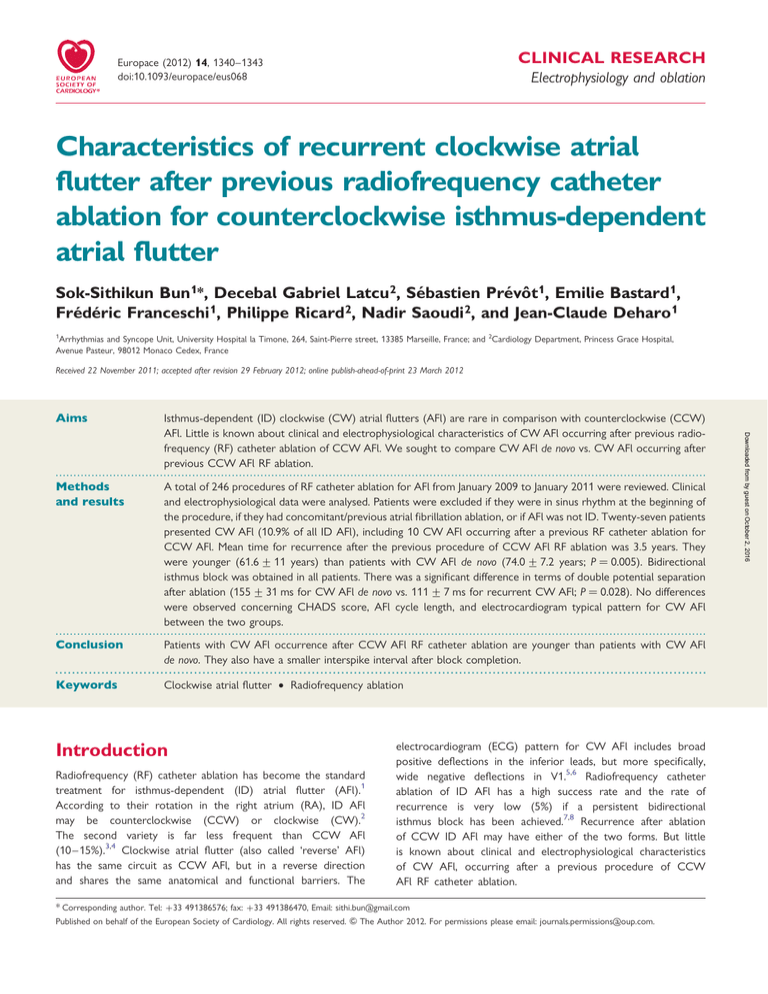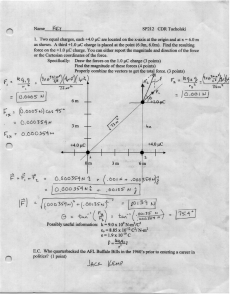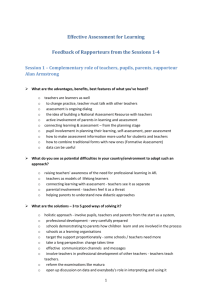
CLINICAL RESEARCH
Europace (2012) 14, 1340–1343
doi:10.1093/europace/eus068
Electrophysiology and oblation
Characteristics of recurrent clockwise atrial
flutter after previous radiofrequency catheter
ablation for counterclockwise isthmus-dependent
atrial flutter
Sok-Sithikun Bun 1*, Decebal Gabriel Latcu 2, Sébastien Prévôt 1, Emilie Bastard 1,
Frédéric Franceschi 1, Philippe Ricard 2, Nadir Saoudi 2, and Jean-Claude Deharo 1
1
Arrhythmias and Syncope Unit, University Hospital la Timone, 264, Saint-Pierre street, 13385 Marseille, France; and 2Cardiology Department, Princess Grace Hospital,
Avenue Pasteur, 98012 Monaco Cedex, France
Received 22 November 2011; accepted after revision 29 February 2012; online publish-ahead-of-print 23 March 2012
Aims
----------------------------------------------------------------------------------------------------------------------------------------------------------Keywords
Clockwise atrial flutter † Radiofrequency ablation
Introduction
Radiofrequency (RF) catheter ablation has become the standard
treatment for isthmus-dependent (ID) atrial flutter (AFl).1
According to their rotation in the right atrium (RA), ID AFl
may be counterclockwise (CCW) or clockwise (CW).2
The second variety is far less frequent than CCW AFl
(10 –15%).3,4 Clockwise atrial flutter (also called ‘reverse’ AFl)
has the same circuit as CCW AFl, but in a reverse direction
and shares the same anatomical and functional barriers. The
electrocardiogram (ECG) pattern for CW AFl includes broad
positive deflections in the inferior leads, but more specifically,
wide negative deflections in V1.5,6 Radiofrequency catheter
ablation of ID AFl has a high success rate and the rate of
recurrence is very low (5%) if a persistent bidirectional
isthmus block has been achieved.7,8 Recurrence after ablation
of CCW ID AFl may have either of the two forms. But little
is known about clinical and electrophysiological characteristics
of CW AFl, occurring after a previous procedure of CCW
AFl RF catheter ablation.
* Corresponding author. Tel: +33 491386576; fax: +33 491386470, Email: sithi.bun@gmail.com
Published on behalf of the European Society of Cardiology. All rights reserved. & The Author 2012. For permissions please email: journals.permissions@oup.com.
Downloaded from by guest on October 2, 2016
Isthmus-dependent (ID) clockwise (CW) atrial flutters (AFl) are rare in comparison with counterclockwise (CCW)
AFl. Little is known about clinical and electrophysiological characteristics of CW AFl occurring after previous radiofrequency (RF) catheter ablation of CCW AFl. We sought to compare CW AFl de novo vs. CW AFl occurring after
previous CCW AFl RF ablation.
.....................................................................................................................................................................................
Methods
A total of 246 procedures of RF catheter ablation for AFl from January 2009 to January 2011 were reviewed. Clinical
and results
and electrophysiological data were analysed. Patients were excluded if they were in sinus rhythm at the beginning of
the procedure, if they had concomitant/previous atrial fibrillation ablation, or if AFl was not ID. Twenty-seven patients
presented CW AFl (10.9% of all ID AFl), including 10 CW AFl occurring after a previous RF catheter ablation for
CCW AFl. Mean time for recurrence after the previous procedure of CCW AFl RF ablation was 3.5 years. They
were younger (61.6 + 11 years) than patients with CW AFl de novo (74.0 + 7.2 years; P ¼ 0.005). Bidirectional
isthmus block was obtained in all patients. There was a significant difference in terms of double potential separation
after ablation (155 + 31 ms for CW AFl de novo vs. 111 + 7 ms for recurrent CW AFl; P ¼ 0.028). No differences
were observed concerning CHADS score, AFl cycle length, and electrocardiogram typical pattern for CW AFl
between the two groups.
.....................................................................................................................................................................................
Conclusion
Patients with CW AFl occurrence after CCW AFl RF catheter ablation are younger than patients with CW AFl
de novo. They also have a smaller interspike interval after block completion.
1341
Characteristics of recurrent clockwise atrial flutter
We sought to compare clinical and electrophysiological features
of ‘recurrent’ CW AFl with de novo CW AFl.
Methods
Statistics
The statistical analysis was made with Stata 9.1 (Statacorp 2005,
College Station, TX, USA). Numerical variables were expressed
as mean + SD. Comparison between the two groups using
continuous variables utilized an unpaired Student’s t-test.
Categorical data were compared by the x2 test with Yate’s correction. A P value ,0.05 was considered significant.
Results
Clinical characteristics
From January 2009 to January 2011, 246 procedures of RF catheter
ablation for AFl were reviewed. Patients were excluded if they
were in sinus rhythm at the beginning of the procedure (n ¼ 70),
or if entrainment manoeuvres failed to demonstrate ID circuit
(n ¼ 118). A bidirectional isthmus block was obtained in all
patients with ID AFl. Among these patients, 27 patients presented
CW AFl (10.9% of all ID AFl), including 10 CW AFls occurring after
a previous RF catheter ablation for CCW AFl. Mean time for recurrence after the previous procedure of CCW AFl RF ablation was
3.5 + 2.1 years.
They were significantly younger (61.6 + 11 years) than patients
with CW AFl de novo (74.0 + 7.2 years; P ¼ 0.005). No difference
was observed concerning the CHADS score (2 + 1.16 in CW AFl
de novo group vs. 1.16 + 0.9 in recurrent CW AFl group), the
presence of arterial hypertension, nor a previous history of AF
(Table 1). No differences were found concerning BMI and BSA
between the two groups (Table 1).
Electrophysiological characteristics
Figure 1 Double potential intervals measurements along the
ablation line, after block completion: vena cava edge (A); middle
of the ablation line (B); ventricular site (C). The grey zone represents the ablation line (cavo-tricuspid isthmus). CS, coronary
sinus; IVC, inferior vena cava; TV, tricuspid valve.
There was a significant difference in terms of double potential separation measured after ablation (111 + 7 ms for recurrent CW AFl
group vs. 155 + 31 ms for CW AFl de novo group; P ¼ 0.028).
When indexed to BSA, double potential intervals were still
found significantly lower in the recurrent CW AFl group (P ,
0.001). No significant differences were observed concerning RR
intervals (81 + 22 b.p.m. in CW AFl de novo group vs. 97 +
15 b.p.m. in recurrent CW AFl group), AFl cycle length (257 +
26 ms in CW AFl de novo group vs. 259 + 29 ms in recurrent
CW AFl group), nor the typical ECG pattern for CW AFl (10/17
in CW AFl de novo group vs. 8/10 in recurrent CW AFl group)
(Table 2). No significant differences were observed between the
two groups concerning procedure time (108 + 11 min in CW
Downloaded from by guest on October 2, 2016
Files of all consecutive patients ablated for ID AFl from January 2009
to January 2011 in our institution (University Hospital la Timone,
Marseille, France) were reviewed. Patients with concomitant/previous
atrial fibrillation (AF) ablation (pulmonary vein isolation) were not
included in this analysis.
Any antiarrhythmic medication was stopped at least five half-lives
before AFl ablation. Ablation procedures were performed in a
fasting state under local anaesthesia; mild sedation by intravenous
bolus of midazolam (1– 2 mg) was administered. During RF delivery,
pain was controlled by the intravenous administration of one and up
to two boluses of 10 mg of nalbuphine. A right femoral venous catheterization was performed. All patients had three catheters inserted:
a duodecapolar halo catheter (Cosio, Bard) placed on the tricuspid
annulus with its distal tip in the antero-inferior right atrium (AIRA), a
8 mm tip ablation catheter (Therapy Dual-8, Irvine Biomedical Inc.,
Irvine, CA, USA), and a diagnostic quadripolar catheter inserted in
the coronary sinus (Dynamic, Xtrem, Sorin Group).
Ablation was performed by creating a line in the cavo-tricuspid
isthmus (CTI) from its ventricular aspect towards the inferior vena
cava ostium. Radiofrequency was delivered with an EP Shuttle
(Stockert GmbH, Freiburg, Germany) generator in a temperaturecontrolled mode (programmed parameters 608, 60 W). The success
of the procedure was defined by the presence of a persistent complete
bidirectional isthmus block, as proved by the CW direction by AIRA
activation sequence when pacing at coronary sinus ostium, and by
the presence of a corridor of separated double potentials along the
ablation line. Double potential intervals were calculated as the mean
value between three measurements along the ablation line at three
sites during coronary sinus ostium pacing: the middle of the line, the
ventricular site, and the vena cava edge (Figure 1).
Clinical data were analysed: age, gender, body mass index (BMI),
body surface area (BSA), CHADS score, the presence of arterial
hypertension, and a history of AF. Electrophysiological and procedural
data were also analysed: RR intervals, AFl cycle length, double potential
intervals after isthmus block completion at the end of the procedure,
double potential intervals indexed to BSA, procedure time, RF application time, and time since the first RF ablation procedure for CCW AFl.
The typical ECG pattern for CW AFl was defined as flutter waves
negative in lead V1 and a ‘sawtooth’ pattern, a shorter plateau
phase, and a widening of the negative component of the F-wave in
the inferior leads (or notched positive F-waves with a distinct isoelectric segment inferiorly)4,6 (Figure 2). All the patients underwent a
standard clinical follow-up including rest ECG and ECG realization in
case of palpitations recurrence, and a 24-hour Holter ECG every
6 months.
1342
S.-S. Bun et al.
Figure 2 A typical pattern of a clockwise isthmus-dependent atrial flutter with a ‘sawtooth’ pattern and a shorter plateau in the inferior leads.
Flutter waves are negative in V1.
CW AFl
de novo
CW AFl
after CCW
AFl ablation
Table 2 Electrophysiological data of patients with
clockwise atrial flutter
P
CW AFl
de novo
................................................................................
................................................................................
Number of patients
17
10
Age of patients (years)
Gender (M/F)
74 + 7
16/1
61 + 9
8/2
0.005
n.s.
CHADS score
2 + 1.16
1.16 + 0.9
0.31
Hypertension
History of atrial fibrillation
10/17
8/17
5/10
8/10
n.s.
n.s.
2
CW AFl
P
after
CCW AFl
ablation
Body mass index (kg/m )
27.7 + 3.0
26.8 + 2.5
0.06
Body surface area (m2)
1.97 + 0.14
1.83 + 0.18
0.69
AFl, atrial flutter; CCW, counterclockwise; CW, clockwise.
AFl de novo group vs. 97 + 19 min in recurrent CW AFl group),
nor RF application time. During the follow-up, one patient had a
recurrence in the CW AFl de novo group and underwent a successful redo procedure. No recurrence was observed in the recurrent
CW AFl group.
Discussion
Our main finding is two-fold. First, patients with CW AFl occurring
after previous CCW AFl ablation are younger than patients with
CW AFl de novo. Second, after RF catheter ablation of RA
isthmus and block completion, they have a smaller interspike
interval.
RR intervals (b.p.m.)
81 + 22
97 + 15
0.16
AFl cycle length (ms)
257 + 26
259 + 29
0.91
Double potential interval after
block completion (ms)
155 + 31
111 + 7
0.028
Double potential interval/body
surface area (ms/m2)
75.4 + 12.2 58.8 + 7.3
,0.001
Electrocardiographic pattern of
CW AFl
10/17
n.s.
8/10
Procedure time (min)
108 + 11
97 + 19
Radiofrequency application
1007 + 118 845 + 233
time (s)
Time since first ablation of CCW
3.5 + 2.1
AFl (years)
Follow-up (months)
Recurrences after CW AFl
ablation
21 + 7
1/17
17 + 2
0/10
0.35
0.49
n.s.
AFl, atrial flutter; CCW, counterclockwise; CW, clockwise.
Diagnosis of CW ID AFl is important, since easily amendable by
RF catheter ablation. In our population, we found the same prevalence of CW AFl (10.9% of ID AFl) than previously reported in the
literature.3,4
Cavo-tricuspid isthmus RF catheter ablation has a high success
rate, when endpoints have been achieved,7,8 with no known difference between the two forms.6,9 Atrial flutter recurrence is due to
Downloaded from by guest on October 2, 2016
Table 1 Clinical characteristics of patients with
clockwise atrial flutter
1343
Characteristics of recurrent clockwise atrial flutter
Limitations
Our study includes a limited number of patients with CW AFl, but
their prevalence is lower than CCW AFl. Furthermore, the low
rate of recurrence associated with ID AFl ablation (5%) explains
the small number of patients with recurrent CW AFl. Mapping
the complete circuit would have been interesting in order to
explain electrophysiological characteristics of CW ID AFl, but
costs of electroanatomical mapping are rarely justified in this
setting. Since the study is retrospective and echocardiographic
evaluation not systematically performed for all patients, RA size
data were not available for comparison.
Conclusion
Patients with CW AFl occurrence after CCW AFl RF catheter
ablation are younger than patients with CW AFl de novo. They
have a smaller interspike interval after block completion. Further
(electro)-anatomical studies will be needed to explain the exact
mechanism responsible for the smaller double potential intervals
in this group.
Conflicts of interest: none declared.
References
1. Blomström-Lundqvist C, Scheinman MM, Aliot EM, Alpert JS, Calkins H, Camm AJ
et al. ACC/AHA/ESC guidelines for the management of patients with supraventricular arrhythmias—executive summary. J Am Coll Cardiol 2003;42:1493 –531.
2. Saoudi N, Cosı́o F, Waldo A, Chen SA, Iesaka Y, Lesh M et al. A classification of
atrial flutter and regular atrial tachycardia according to electrophysiological
mechanisms and anatomical bases; a statement from a Joint Expert Group from
The Working Group of Arrhythmias of the European Society of Cardiology
and the North American Society of Pacing and Electrophysiology. Eur Heart J
2001;22:1162 – 82.
3. Milliez P, Richardon WA, Obioha-Ngwu O, Zimetbaum PJ, Papageorgiou P,
Josephson ME. Variable electrocardiographic characteristics of isthmusdependent atrial flutter. J Am Coll Cardiol 2002;40:1125 –32.
4. Cosio FG, Goicolea A, Lopez-Gil M, Arribas F, Barroso JL, Chicote R. Atrial endocardial mapping in the rare form of atrial flutter. Am J Cardiol 1991;66:715 –20.
5. Kalman JM, Olgin JE, Saxon LA, Lee RJ, Scheinman MM, Lesh MD. Electrocardiographic and electrophysiologic characterization of atypical atrial flutter in man: use
of activation and entrainment mapping and implications for catheter ablation.
J Cardiovasc Electrophysiol 1996;8:121 –44.
6. Saoudi N, Nair M, Abdelazziz A, Poty H, Daou A, Clementy J et al. Electrocardiographic patterns and results of radiofrequency catheter ablation of clockwise type
I atrial flutter. J Cardiovasc Electrophysiol 1996;7:931 –32.
7. Perez FJ, Schubert CM, Parvez B, Pathak V, Ellenbogen KA, Wood MA. Long-term
outcomes after catheter ablation of cavo-tricuspid isthmus dependent atrial
flutter : a meta-analysis. Circ Arrhythmia Electrophysiol 2009;2:393 – 401.
8. Poty H, Saoudi N, Abdel Aziz A, Nair M, Letac B. Radiofrequency catheter
ablation of type 1 atrial flutter. Prediction of late success by electrophysiological
criteria. Circulation 1995;92:1389 –92.
9. Tai CT, Chen SA, Chiang CE, Lee SH, Ueng KC, Wen ZC et al. Electrophysiologic
characteristics and radiofrequency catheter ablation in patients with clockwise
atrial flutter. J Cardiovasc Electrophysiol 1997;8:24 –34.
10. Lo LW, Tai CT, Lin YJ, Chang SL, Wongcharoen W, Tuan TC et al. Characteristics
of the cavotricuspid isthmus in predicting recurrent conduction in the long-term
follow-up. J Cardiovasc Electrophysiol 2009;20:39–43.
11. Da Costa A, Faure E, Thévenin J, Messier M, Bernard S, Abdel K et al. Effect of
isthmus anatomy and ablation catheter on radiofrequency catheter ablation of
the cavotricuspid isthmus. Circulation 2004;110:1030 –5.
12. Ventura R, Klemm H, Lutomsky B, Demir C, Rostock T, Weiss C et al. Pattern of
isthmus conduction recovery using open cooled and solid large-tip catheters for
radiofrequency ablation of typical atrial flutter. J Cardiovasc Electrophysiol 2004;15:
1126 –30.
13. Matsuo S, Yamane T, Tokuda M, Date T, Hioki M, Narui R et al. Prospective randomized comparison of a steerable versus a non-steerable sheath for typical atrial
flutter ablation. Europace 2010;12:402 –9.
14. Tai CT, Haque A, Lin YK, Tsao HM, Ding YA, Chang MS et al. Double potential
interval and transisthmus conduction time for prediction of cavotricuspid isthmus
block after ablation of typical atrial flutter. J Interv Card Electrophysiol 2002;7:
77 – 82.
Downloaded from by guest on October 2, 2016
a persistent gap in CTI, often due to anatomical difficulties10,11 and
reablation may require an irrigated tip or a sheath to improve catheter stability.12,13 One would assume that recurrent CW AFl is
more difficult to ablate than CW AFl de novo; however, in our
series no difference was found in terms of procedure time or RF
application time between the two groups of CW AFl.
To the best of our knowledge, no study has been performed to
explain why AFl recurrences occur with a CW or a CCW rotation.
Concerning the smaller double potential interval found in the
recurrent CW AFl group, an incomplete CTI block is unlikely
because the mean value (111 ms) is higher than the cut-off definition for complete CTI block.14 One hypothesis would be that this
specific population may have a smaller or possibly more rapidly
conducting RA. No differences were observed concerning BMI
and BSA between the two groups. Nevertheless, when indexed
to BSA, double potential intervals were found significantly lower
in the recurrent CW AFl group than in the CW AFl de novo
group. In the literature, there is no clear correlation between
BMI or BSA and RA volume, irrespective of the underlying cardiopathy. Echocardiographic assessment of RA size was seldom available since this exam was not systematically performed before
ablation. An anatomic study of CTI would have been interesting
in the two groups to identify possible anatomical discrepancies
likely to explain a smaller interspike interval in the recurrent
CW AFl group. Nevertheless, an incomplete isthmus block
cannot be 100% ruled out, even in cases of descending activation
patterns of the AIRA while pacing septally to the ablation line.
Thus, in very few cases, an incomplete block may be responsible
for a smaller interspike separation in recurrent CW AFl patients.
Nevertheless, even if incomplete block was responsible for the
smaller double potential intervals in this group, this was not associated with a higher rate of recurrence during the follow-up, in
comparison with the CW AFl de novo group.




